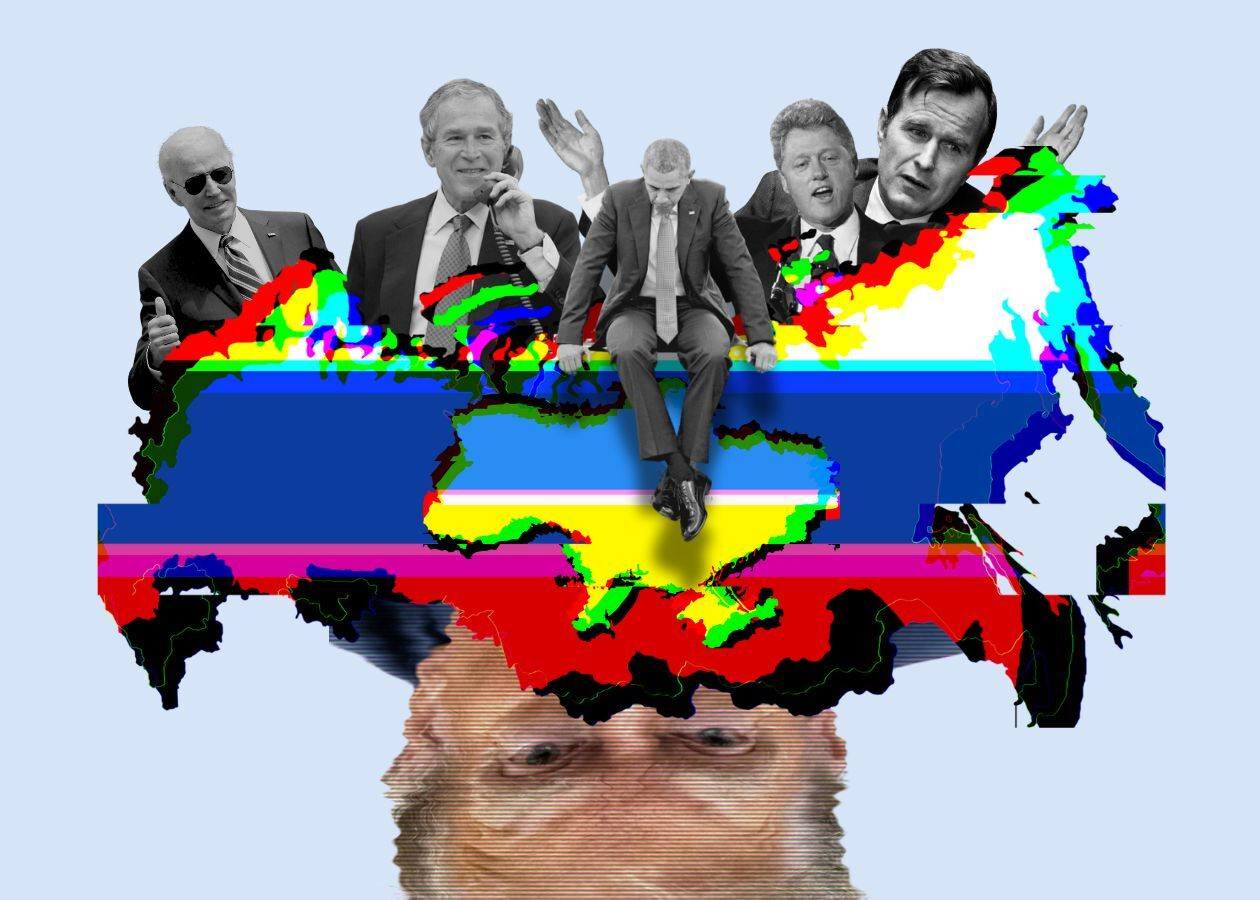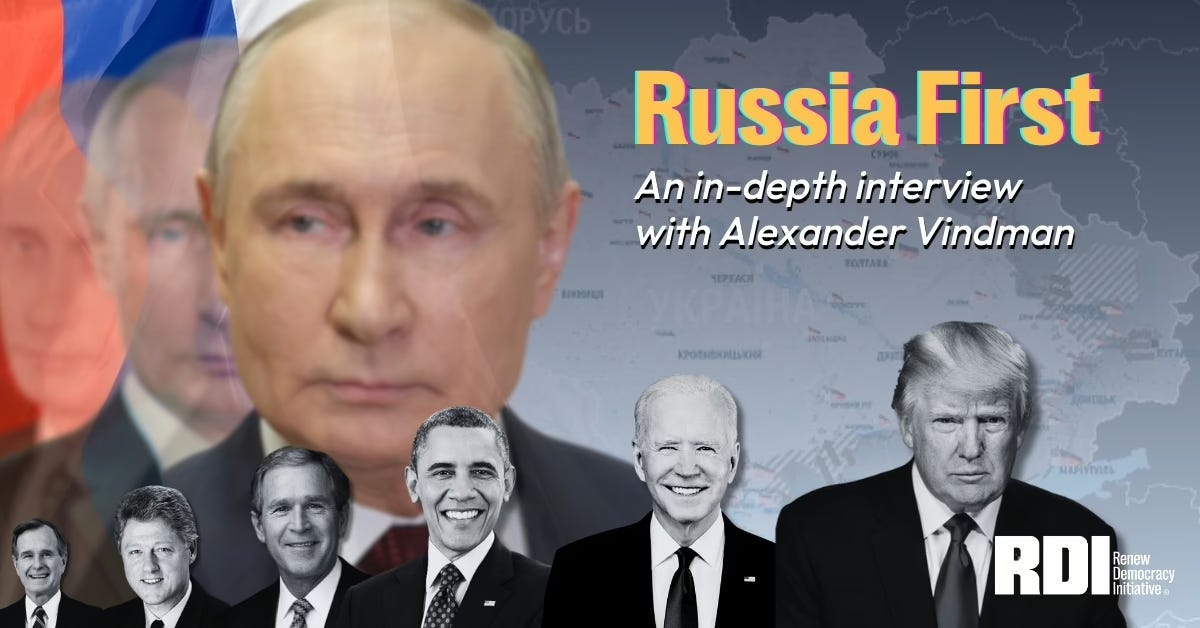America’s Failure on Ukraine-Russia is a Team Effort
Misguided US policy on Eastern Europe has proven resilient and bipartisan.
Over the past three months, the United States has, in turns, sought to abandon Ukraine to Russia… and then tried to get too close, with proposals aimed at seizing and exploiting Ukrainian resources. In doing so, President Trump and his allies are putting on an unflattering reenactment of the 1930s that is one-part Chamberlain, one-part Stalin. All of this is culminating in a so-called “peace plan” that freezes the frontlines and makes millions of Ukrainians permanent hostages of a genocidal Russian military dictatorship.
As with many things related to America’s forty-fifth and forty-seventh president, Trump’s Ukraine-Russia policy is an extreme reaction to a multi-system failure decades in the making. That story begins under the first President Bush when the Soviet Union still existed—albeit mostly on paper.
I distinctly recall visiting Washington, DC toward the end of November 1991. I wasn’t the only prominent soon-to-be-former Soviet passing through town. The Bush administration was hosting Gorbachev’s newly reappointed Foreign Minister Eduard Shevardnadze to discuss a “new dawn” in US-USSR relations. Being made foreign minister of the Soviet Union in late fall of ‘91 was a little like being promoted to first officer on the Titanic with six compartments flooded: a fancy title on a sinking ship (or, as a contemporary Russian song put it, a “train on fire”).
It’s not that George Bush, or his secretary of state and close advisor, Jim Baker, lacked the foresight to know that the Soviet Union was not long for this world. Nor were they wanting for the basic situational awareness to see the damage done by the KGB-backed coup that August. What they exhibited was fear—a fear of risks, of upsetting the geopolitical status quo, of rocking the boat too much.
That fear loomed large over the elder Bush when he addressed the Ukrainian parliament, admonishing them to not declare independence. He preferred the Soviet devil he knew to the unknowns of freedom. And to be fair, freedom does carry a lot of uncertainty. But tyranny is always a bad bet. In any event, Ukrainians defied the president just four months later, when they voted overwhelmingly in a referendum for a divorce from the dying communist empire.
Bush’s fear of disruption has proven resilient and bipartisan. Americans saw it on display during the last administration. President Joe Biden repeatedly affirmed that the United States would stand with Ukraine in its war against Russia “for as long as it takes”—to which I, and many others, often responded: for as long as it takes to do what, exactly?
The consistent message should always have been an unequivocal endorsement of Ukrainian victory and Russian defeat. Biden and his advisors let the theoretical consequences of the Putin regime’s collapse supersede their interest in stopping the real, ongoing Russian atrocities in Ukraine. On the other hand, a full-throated endorsement of Ukrainian victory from Biden would have been a dishonest publicity stunt, given how slowly Washington moved to equip Kyiv. The cost of delays in delivering tanks, fighter jets, and artillery are counted not only in weeks and months, but in Ukrainian lives.
Unlike George H.W. Bush and Joe Biden, Bill Clinton was not afraid of Russia. What he was guilty of was simply not investing the energy needed to responsibly shepherd America’s ties with the Kremlin, or with Kyiv for that matter. In a word: negligence. He demanded Ukraine cede its share of the Soviet nuclear arsenal to Moscow, while Ukraine received loose “security assurances” from the US, Russia, and Great Britain. Those assurances have aged like milk.
Meanwhile, as my friend and RDI board member Alex Vindman points out, some of the nuclear-capable bombers Ukraine handed over to Russia in the US-brokered deals of the 1990s are now being flown on missions against Ukrainian innocents. Small wonder that Ukraine wants firm commitments from its allies today.
I count fear and negligence among several vices on display in American policy toward Ukraine and Russia in the thirty-some years leading up to the second Trump administration. For some American officials, there was also an irresistible urge to try to forge a partnership with a malevolent, dangerous Russia, despite all of the evidence undermining this approach. “I looked the man in the eye,” George W. Bush claimed of Vladimir Putin. “I found him to be very straightforward and trustworthy."
Having dealt with Putin’s thugs, I can tell you that straightforward and trustworthy are not words I would use to describe the Russian dictator. But W fell under his spell. He bought into the Kremlin’s superficial overtures about being an ally in the war on terror, even as Moscow courted terrorists in Tehran, Damascus, and Pyongyang. It should come as no surprise that the younger Bush was caught flat-footed when Russia invaded Georgia in 2008.
President Obama took his predecessor’s misplaced trust of Russia to a new level. After watching Moscow attack a smaller neighbor at the end of the last administration, Obama somehow reached the conclusion that Russia had earned a reset in its relations with the United States. Secretary of State Hillary Clinton literally presented Foreign Minister Sergei Lavrov with a red reset button—or at least she tried to. The button Secretary Clinton presented to Lavrov was meant to have the Russian word perezagruzka (reset) written on it. Instead, the label read peregruzka (overload). It’s a gaffe so overbearing in its symbolism that no competent screenwriter would dare include it in a movie or TV show, but alas, this was real life.
Obama’s team was indeed overloaded by the onslaught of Russian misbehavior in spite of the reset. The invasion of eastern Ukraine and annexation of Crimea. The intervention in Syria on behalf of the Assad regime. The Russian government’s murder of political dissidents—including killing Boris Nemtsov on the steps of the Kremlin in what resembled a public execution. And finally, there was Russia’s interference in the 2016 American presidential election. The US actually declined to provide Ukraine with lethal military aid in 2014: in this sense, Trump’s (hyperbolic) quip that he gave Ukraine Javelin anti-tank missiles while Obama only gave blankets is not so far off the mark.
Now, why am I saying this?
The Trump administration’s current moves on Russia and Ukraine are malicious, not simply misguided. They are unlikely to course correct because they are certain that their course is indeed correct. But there are members of Congress from both parties who still support Ukraine. There are American voters who need to understand what a strong American stance in Eastern Europe looks like.
Trump’s critics have properly identified the president as a useful idiot (or worse) for the Russians. But if we are to avoid repeating past mistakes, then we must also recognize that a weak policy that’s pro-Ukraine in name is not much better than a confidently pro-Russian policy.
The ongoing betrayal of Ukraine is Trump’s sin, but reaching this terrible juncture was a team effort with support from Democrats and Republicans alike.
Related Content
Russia First
Shortly after the third anniversary of Russia’s full-scale invasion of Ukraine, RDI Board Member Alexander Vindman published his second book, The Folly of Realism: How the West Deceived Itself About Russia and Betrayed Ukraine.





I disagree that a weak pro-Ukraine policy is not much better than a pro-Russia policy. A pro-Russia policy would be so destructive with no benefits to anyone other than Trump’s and Putin’s family and friends.
But it’s certainly true that our US foreign policy towards Russia has failed over and over. And I’m not sure we’ve had a foreign policy towards Ukraine.
This is a brilliant piece and educated me so much in things I sadly have not known as much as I should have. Things make more sense to me now. Praying for Ukraine daily, and DJT's betrayal of Ukraine is top of my list of unforgivables from this "regime." Thank you.